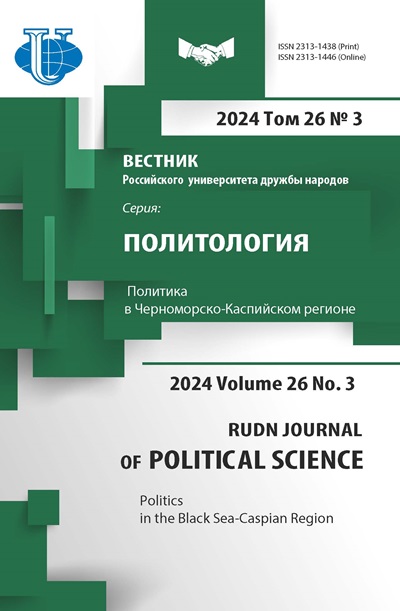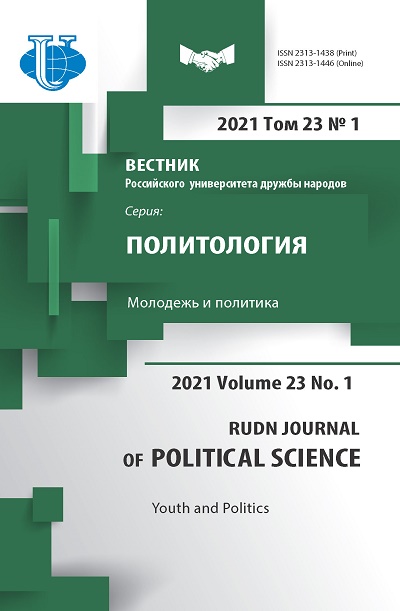Role and Features of Youth Political Online Activism in Modern Russia
- Authors: Negrov E.O.1
-
Affiliations:
- Saint Petersburg State University
- Issue: Vol 23, No 1 (2021): Youth and Politics
- Pages: 18-30
- Section: YOUTH IN POLITICS
- URL: https://journals.rudn.ru/political-science/article/view/25708
- DOI: https://doi.org/10.22363/2313-1438-2021-23-1-18-30
Cite item
Full Text
Abstract
The presented article is a study dealing with the role and characteristics of youth political online activism in modern Russia. The relevance, main aspects and criteria of the effectiveness of youth policy in the field of communication are considered. There are following basic steps suggested: to improve the effectiveness of such communication associated with a clear articulation of the needs of various groups of people through competent socio-political monitoring with independent quantitative and qualitative research. Building a constructive dialogue to promote positive, constructive and conventional activation of the political behavior of youth groups; work to overcome the apolitical and absentee tendencies of young people, as well as the expansion of the political and managerial concept of “Electronic state” not only formally, but also substantively, are among these steps. Further, the study analyzes the structure of protest behavior, distinguishes several levels of protest consideration, each of which has its own specifics and features for the analysis. This is the level of deep reasons and specific motive for the emergence of a public protest; the level of the dominant style of public manifestation of any protest moods, which has its basis in the predominantly psycho-emotional sphere; and, finally, the level of peculiarities of political behavior with very specific tactics and strategies of protest behavior. It draws attention to the fact that youth as a social group is heterogeneous and it seems appropriate to divide its age structure into three stages (from 14 to 20, years old, from 21 to 24 years old, and from 25 to 30 years old). The final part of the article deals with the models of virtual protest behavior. The model of a complete unstructured protest is highlighted; activity-target co-optation; proactive-loyalist; adaptation and frustration; politicized civil and local models. The results obtained to date make it possible to record the essential features of online mobilization, both based on the features of the functioning of the virtual space, and from the point of view of the main object of research: youth and the specifics of its identity and algorithms of political behavior. All this allows us to speak about the relevance of the constructed classification models for various mobilization mechanisms, which determines the practical significance of the study.
About the authors
Evgeny Olegovich Negrov
Saint Petersburg State University
Author for correspondence.
Email: st007528@mail.spbu.ru
PhD in Political Science, Associate Professor of the Department of Political Institutions and Applied Political Research of the Faculty of Political Science
Saint Petersburg, RussiaReferences
- Akhremenko, A. S., Stukal, D. K., & Petrov, A. P. (2020). Network or text? Factors of protest spread in social media: Theory and data analysis. Polis. Political Studies, 2, 73–91. doi: 10.17976/jpps/2020.02.06. (In Russian).
- Akhtsiev, I. M. (2020). Transformation of the political behavior of youth in modern russian society. Fundamental and Applied Research: Topical Issues, Achievements and Innovations. Collection of Articles of the XXXVI International Scientific and Practical Conference. Penza, 236–242. (In Russian).
- Arkhipova, A. S., Radchenko, D. A., Titkov, A. S., Kozlova, I. V., Yugai, E. F., Belyanin, S. V., & Gavrilova, M. V. (2018). «Rally Rebuild»: Internet in protest and protest on the internet. Monitoring of Public Opinion: Economic and Social Changes, 1, 12–35. doi: 10.14515/monitoring.2018.1.02. (In Russian).
- Castells, M. (2016). Power of Communication. Moscow: Higher School of Economics. (In Russian).
- Gavrilov, S. D., & Makarenko, K. M. (2020). The nature of political mobilization in the regional public space of the Volgograd Region. Bulletin of the Volgograd State University. Series History. Regional Studies. International Relationships, 25(3), 192–203. doi: 10.15688/jvolsu4.2020.3.17. (In Russian).
- Giddens, E. (2004). The Elusive World. How Globalization Changes Our Lives. Moscow: Ves Mir. ISBN 5-7777-0304-6. (In Russian).
- Inglehart, R. F. (2018). Cultural Evolution. How Human Motivations Change and How It Changes the World. Moscow: Mysl. ISBN 978-5-244-01202-6. (In Russian).
- Kaftan, V. V. (2018). Forms and phenomena of mass communication. Journal of Philosophical Research, 4(1), 26–42. (In Russian).
- Kaliev, A. A. (2020). Transformation of protest measures in the context of the developing the fourth industrial revolution. Questions of Russian and International Law, 10(4а), 189–196. doi: 10.34670/AR.2020.12.94.024. (In Russian).
- Lagutin, O. V., & Negrov, E. O. (2019). Models of political behavior of youth middle class of modern agglomerations: On the example of the main regions of the North-West and South Siberia. RUDN Journal of Political Science, 2019, 21(2), 157–174. doi: 10.22363/2313-1438-2019-21-2-157-174. (In Russian).
- Makarenko, K. M. (2020). Politicization of civil protest in the public space of modern Russia. Bulletin of the Tula State University. Humanitarian Sciences, 1, 12–20. (In Russian).
- Martyanov, D. S. (Eds). Structure and Discourse of the Virtual Elite 2.0 in Russia: Monographic research. Saint Petersburg: ElekSis. (In Russian).
- Ponomarev, N. A., Belov, S. I., & Mailis, A. A. (2018). Counteracting the growth of youth involvement in radical political protest (based on the materials of mass demonstrations in 2017). Public Administration. Electronic Bulletin, 67, 150–169. (In Russian).
- Potseluev, S. P. (2008). Political Paradialogues. Rostov-on-Don: SFedU Publishing House. (In Russian).
- Pyrma, R. V. (2019). Protest mood of Russian youth in the digital network. Humanities. Financial University Bulletin, 9(6), 100–110. doi: 10.26794/2226-7867-2019-9-6-100-110. (In Russian).
- Riekkinen, M. A. (2017). Attracting underage youth to social and political life: International law and legislation of the Russian Federation. Legal Science, 5, 36–43. (In Russian).
- Titov, V. V. (2020). Strategies of social protest of youth in Runet: A comparative analysis of generations Y and Z. Monitoring of Public Opinion: Economic and Social Changes, 3, 139–158. doi: 10.14515/monitoring.2020.3.1674. (In Russian).
- Ushkin, S. G. (2014). Involvement of users of social networks in the protest movement. Power, 8, 139–142. (In Russian).
- We Are Not Slaves! Anthropology of Protest in Russia in 2011–2012. (2014). A. Arkhipova & M. Alekseevsky (Eds.). Tartu. (In Russian).
















